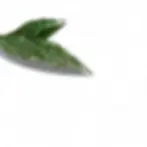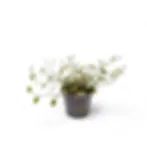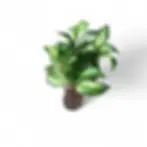Peperomia rotundifolia – Trailing Charm for Your Indoor Jungle
Peperomia rotundifolia, also called trailing jade or round-leaf peperomia, is a low-maintenance trailing plant with small, succulent-like leaves on soft, cascading stems. Its vibrant green foliage and delicate structure make it perfect for shelves, hanging pots or even terrariums. Despite its dainty look, it’s tough, compact and thrives with little effort — ideal for plant beginners or anyone looking for a stylish space-saver.
● Why Peperomia rotundifolia Belongs in Your Space
- Natural Trailing Habit: Grows long, elegant stems that hang and weave beautifully.
- Space-Efficient: Compact size fits well on windowsills, desks, and shelves.
- Moisture-Storing Leaves: Reduces watering needs thanks to semi-succulent foliage.
- Humidity Tolerant: Does well in typical household humidity (40 – 60%).
- Pet-Friendly: Non-toxic to cats and dogs.
● Peperomia rotundifolia in Its Natural Element
This species is native to tropical Central and South America, especially Colombia, Ecuador and Brazil. In the wild, it grows as a creeping epiphyte or groundcover under the canopy, benefiting from filtered light and organic-rich substrates. Indoors, it remains compact — usually not exceeding 30 cm in length — and spreads gently over time.
- Growth Form: Creeping or trailing with flexible, intertwining stems.
- Indoor Size: Reaches up to 30 cm in length.
- Growth Speed: Slow to moderate under optimal light.
- Toxicity: Non-toxic to pets and people.
- Lifespan: Long-lived with minimal care.
● How to Keep Peperomia rotundifolia Thriving Indoors
- Light: Prefers bright, filtered daylight; tolerates lower light but grows slower.
- Watering: Let the top layer of soil dry out before watering; avoid soggy roots.
- Humidity: Comfortable with typical room humidity.
- Temperature: Best kept between 18 – 27°C. Avoid cold drafts and temps below 10°C.
- Substrate: Use a chunky, well-draining mix — coconut coir, orchid bark, and perlite work well.
- Fertiliser: Apply diluted liquid fertiliser every 4 – 6 weeks for healthy growth.
- Repotting: Only when root-bound; choose a shallow pot with drainage holes.
- Propagation: Root stem cuttings in water or soil — easy and rewarding.
- Semi-Hydro: Adapts to LECA setups if transitioned properly.
- Pruning: Snip leggy stems to maintain shape and encourage bushier growth.
● Troubleshooting Tips for Peperomia rotundifolia
- Yellowing Leaves: Usually a sign of overwatering — let soil dry a bit more.
- Stretchy Growth: Needs more light — move closer to a window.
- Wrinkled Leaves: Underwatered — check moisture and adjust your routine.
- Pests: Occasionally affected by spider mites or mealybugs. Treat with neem oil or insecticidal soap.
- Root Issues: Poor drainage can cause rot — repot into airy soil mix.
- Leaf Spots: Improve airflow and avoid overhead watering if fungal spots appear.
- Brown Tips: Often linked to inconsistent watering or very dry air.
● Extra Details for Plant Lovers
- Ideal Spot: East or north-facing window with soft natural light.
- Terrarium Use: Great in closed or open terrariums due to its size and texture.
- Child and Pet Safe: Confirmed non-toxic by the ASPCA.
● Botanical Background and Name Origins
Peperomia rotundifolia (L.) Kunth was originally classified as Piper rotundifolium by Carl Linnaeus. Kunth reassigned it to the Peperomia genus in 1815, published in Nova Genera et Species Plantarum. The genus name "Peperomia" combines the Greek "peperi" (pepper) and "homoios" (resembling), referencing its relation to the pepper family (Piperaceae). The species name "rotundifolia" means "round-leaved", accurately describing its tiny, circular foliage.
Family: PiperaceaeAccepted Name: Peperomia rotundifolia (L.) KunthBasionym: Piper rotundifolium L.Published: Nova Genera et Species Plantarum 1: 55 (1815)Native to: Colombia, Brazil, Ecuador, and other parts of tropical Central and South America
● Your Questions About Peperomia rotundifolia, Answered
- Can it handle low light? It survives, but thrives in gentle, indirect daylight.
- What’s the best way to propagate it? Stem cuttings in water or soil — both work well.
- Is it suitable for small spaces? Absolutely — its compact trailing form fits almost anywhere.
- Does it need regular pruning? Light pruning helps it stay bushy and neat.
Order Peperomia rotundifolia Now – Add this versatile trailing gem to your home! It’s beginner-friendly, pet-safe, and a perfect fit for terrariums or hanging planters. Shop today and bring a touch of green softness to your indoor space.
Peperomia rotundifolia
Peperomia rotundifolia comes in following sizes:
Baby Plant – is approximately 10 cm tall and comes in a ⌀ 5 cm pot.
S – is approximately 15 cm tall and comes in a ⌀ 10 cm pot.
M – is approximately 20 cm tall and comes in a ⌀ 12 cm pot.






























